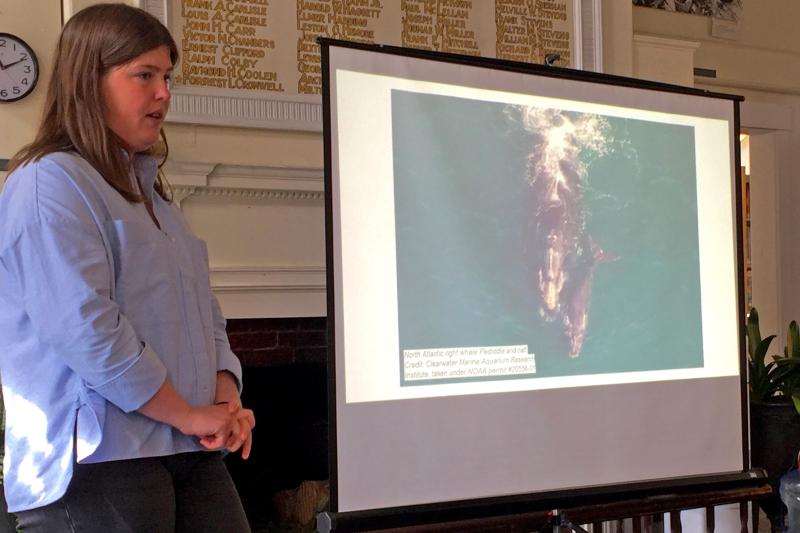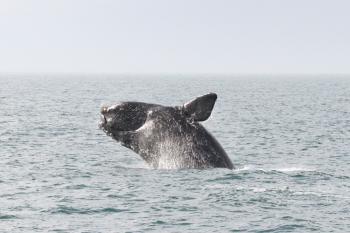Camille Ross knew she wanted to study whales ever since she was 3. Now a University of Maine doctoral student and a researcher with Bigelow Laboratory, she does just that. Ross shared her passion about the North Atlantic right whale, and its habitats and behavior, at Boothbay Harbor Memorial Library April 19.
North Atlantic right whales have been in the middle of intense debate around environmental protection, fishing regulations and potential threats to the endangered species that sometimes calls the Gulf of Maine home. Despite the attention around them, their importance to the ecosystem is not often talked about, Ross said.
She said whales enhance critical ecological processes and help move key nutrients between surface waters and the seafloor; and when they die, their bodies can become feeding grounds for organisms at the ocean bottom, some of which scientists think may only exist on their carcasses.
Scientists also think whales could play a valuable role in helping to fight climate change because they accumulate carbon in their massive bodies. According to the International Monetary Fund, an average great whale stores 33 tons of carbon dioxide over its lifetime that sinks to bottom of the ocean when it dies, taking that carbon out of the atmosphere for centuries.
These interactions are part of ecological webs that support the $150 billion global fishing industry and the $2 billion global whale watching industry, according to a 2019 report from the International Monetary Fund.
However, North Atlantic right whales are now critically endangered: According to Ross and the National Oceanographic and Atmospheric Administration (NOAA), by the early 1890s, whalers had brought North Atlantic right whales to the brink of extinction. They were named “right whales” because they were the right whales to hunt: they swim close to shore in shallow waters, float when they die and move slowly.
According to NOAA, there are only about 350 North Atlantic right whales left and only around 70 of those are breeding females. Changing conditions makes repopulating the species, and even studying them, increasingly hard. Ross’ research has focused on using computer models to help locate and study whales based on suitable habitats, namely where they can find food.
North Atlantic right whales eat about 395,000 calories per day compared to a human’s 2,000. Most of their meals consist of a copepod that is smaller than a grain of rice, which means they eat a lot. “These are incredibly tiny creatures, and the whales have to eat them to survive,” Ross said. “The question becomes how do they go about doing that?”
Historically, healthy populations of North Atlantic right whales had their calves as far south as Florida, fed in the spring and early summer in Cape Cod Bay and, by late summer and fall, found food in the Gulf of Maine up to the Bay of Fundy. Predictable habits helped researchers study the whales because they knew where to look. North Atlantic right whale populations were recovering until around 2010, according to Ross. At that time, rising deep-water temperatures changed the location of their key food source, which also became scarcer. In addition, sea surface water temperatures have been rising, especially in the Gulf of Maine.
Ross said the combination of these factors has led to a decline in North Atlantic right whales and their health; the Southern right whales in Patagonia, where conditions have remained cooler and more pristine, are visibly larger and healthier.
At present, North Atlantic right whales are found in much sparser concentrations and further north in Canada around the Gulf of Saint Lawrence. However, researchers have still not found predictable summer feeding grounds. Without knowing where the whales are, Ross said, it is hard to protect them.
The next step in her work is a project in collaboration with researchers from Maine Department of Marine Resources. Ross and her colleagues plan to use passive acoustic buoys that can monitor whale activity along coastal Maine to learn about the whales’ location and behavior. This research could help efforts to conserve, and hopefully rebuild, the population.
“They’re way more complex creatures than we give them credit for,” said Ross. “The way that they move through the environment is very unique. It's cool to see these animals persist through different shifts in climate over hundreds of years.”
































.png)
.png)
